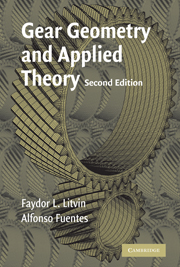Book contents
- Frontmatter
- Contents
- Foreword by Graziano Curti
- Preface
- Acknowledgments
- 1 Coordinate Transformation
- 2 Relative Velocity
- 3 Centrodes, Axodes, and Operating Pitch Surfaces
- 4 Planar Curves
- 5 Surfaces
- 6 Conjugated Surfaces and Curves
- 7 Curvatures of Surfaces and Curves
- 8 Mating Surfaces: Curvature Relations, Contact Ellipse
- 9 Computerized Simulation of Meshing and Contact
- 10 Spur Involute Gears
- 11 Internal Involute Gears
- 12 Noncircular Gears
- 13 Cycloidal Gearing
- 14 Involute Helical Gears with Parallel Axes
- 15 Modified Involute Gears
- 16 Involute Helical Gears with Crossed Axes
- 17 New Version of Novikov–Wildhaber Helical Gears
- 18 Face-Gear Drives
- 19 Worm-Gear Drives with Cylindrical Worms
- 20 Double-Enveloping Worm-Gear Drives
- 21 Spiral Bevel Gears
- 22 Hypoid Gear Drives
- 23 Planetary Gear Trains
- 24 Generation of Helicoids
- 25 Design of Flyblades
- 26 Generation of Surfaces by CNC Machines
- 27 Overwire (Ball) Measurement
- 28 Minimization of Deviations of Gear Real Tooth Surfaces
- References
- Index
19 - Worm-Gear Drives with Cylindrical Worms
Published online by Cambridge University Press: 04 September 2009
- Frontmatter
- Contents
- Foreword by Graziano Curti
- Preface
- Acknowledgments
- 1 Coordinate Transformation
- 2 Relative Velocity
- 3 Centrodes, Axodes, and Operating Pitch Surfaces
- 4 Planar Curves
- 5 Surfaces
- 6 Conjugated Surfaces and Curves
- 7 Curvatures of Surfaces and Curves
- 8 Mating Surfaces: Curvature Relations, Contact Ellipse
- 9 Computerized Simulation of Meshing and Contact
- 10 Spur Involute Gears
- 11 Internal Involute Gears
- 12 Noncircular Gears
- 13 Cycloidal Gearing
- 14 Involute Helical Gears with Parallel Axes
- 15 Modified Involute Gears
- 16 Involute Helical Gears with Crossed Axes
- 17 New Version of Novikov–Wildhaber Helical Gears
- 18 Face-Gear Drives
- 19 Worm-Gear Drives with Cylindrical Worms
- 20 Double-Enveloping Worm-Gear Drives
- 21 Spiral Bevel Gears
- 22 Hypoid Gear Drives
- 23 Planetary Gear Trains
- 24 Generation of Helicoids
- 25 Design of Flyblades
- 26 Generation of Surfaces by CNC Machines
- 27 Overwire (Ball) Measurement
- 28 Minimization of Deviations of Gear Real Tooth Surfaces
- References
- Index
Summary
INTRODUCTION
There are two types of worm-gear drives: (i) those with cylindrical worms (Fig. 19.1.1) (single-enveloping worm-gear drives), and (ii) those with hourglass worms (see Chapter 20) (double-enveloping worm-gear drives). The terms “single-enveloping” and “double-enveloping” are confusing because in both cases the surface of the worm-gear tooth is the envelope to the one-parameter family of worm thread surfaces that are generated in the coordinate system rigidly connected to the worm-gear. The thread surface of a cylindrical worm is a helicoid. (We recall that a helicoid is the surface that is generated by a given curve while it performs a screw motion.)
This chapter covers (i) the generation and geometry of cylindrical worms, and (ii) the basic design problems (relations between design parameters). Depending on the method for generation, we differentiate henceforth the following types of cylindrical worms (see German Standards DIN 3975):
(i) ZA worms, with surface A. The worm surface is a ruled surface that is generated by a straight line while it performs a screw motion with respect to the worm axis. The generating line intersects the worm axis and therefore the axial section of the worm surface is a straight line that is just the generating line. The cross section of the ZA worm is an Archimedes spiral (see Section 19.4).
(ii) ZN worms, with surface N. The worm surface is also a ruled surface. However, the generating line lies in a plane that passes through the perpendicular to the worm axis and forms angle λp with the worm axis (see Section 19.5). Here, λp is the lead angle on the pitch cylinder on the worm. The cross section of the worm is an extended involute (see Section 19.5)
[…]
- Type
- Chapter
- Information
- Gear Geometry and Applied Theory , pp. 547 - 613Publisher: Cambridge University PressPrint publication year: 2004



